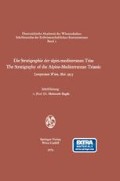Zusammenfassung
Bei der flächenhaften Grabung „Punkt 902“ des Paläontologischen Instituts und Museums der Universität Zürich in der Grenzbitumenzone des Monte San Giorgio (Kanton Tessin, Schweiz) wurden neben zahlreichen Skeletten von marinen Fischen und Reptilien auch Reste von Lamellibranchiata (vorwiegend Daonellen) und Ammonoideen gefunden.
In der Grenzbitumenzone des Monte San Giorgio wurden bisher 44 Ammonoideen-Arten und -Unterarten, die sich auf 15 Gattungen verteilen, festgestellt. Bei einigen Ammonoideen-Arten variiert die Skulptur und der Gehäusequerschnitt in sehr weiten Grenzen.
Die stratigraphische Auswertung der Ammonoideen ergab, daß die Grenzbitumenzone in das höchste Anis (polymorphus-Zone) und das tiefste Ladin einzustufen ist.
Die Ceratiten des germanischen Muschelkalkes leiten sich wahrscheinlich von den sehr ähnlichen Serpianiten des höchsten Anis ab.
Summary
Systematic excavations executed by the Paleontological Institute and Museum of the University of Zürich within the “Grenzbitumenzone” on “Punkt 902” of the Monte San Giorgio (Canton Ticino, Switzerland) yielded also Lamellibranchia (especially Daonella) and Ammonoidea besides the famous marine fishes and reptils.
Altogether there were determined within the Grenzbitumenzone 44 species and subspecies belonging to 15 genera of the Ammonoidea. The sculpture and the section of the representatives of some species is varying in very large bounds.
The stratigraphic interpretation of the Ammonoidea has given the result, that the Grenzbitumenzone belongs to the uppermost part of the Anisian (polymorphus zone) and to the lowermost of the Ladinian.
It is presumed that the genus Ceratites s. s. of the germanic basin is an ascendant of the very similar Genus Serpianites of the Grenzbitumenzone.
Access this chapter
Tax calculation will be finalised at checkout
Purchases are for personal use only
Preview
Unable to display preview. Download preview PDF.
Literaturauswahl
Airaghi, C. (1912): I Molluschi delgi scisti bituminosi di Besano in Lombardia.— Atti. Soc. ital. Sci. nat. 51, 1–30, 1 Abb., Taf. 1-4.
Assereto, R. (1969): Sul significato stratigrafico della „Zona ad Avisianus“ del Trias medio nelle Alpl. — Boll. Soc. geol. ital. 88 (1), 123–145, 2 Abb., 1 Tab.
Bittner, A. (1896): Bemerkungen zur Neuesten Nomenklatur der alpinen Trias. — 32 S., Wien (Hollinek).
Frauenfelder, A. (1916): Beiträge zur Geologie der Tessiner Kalkalpen. — Eclog. geol. Helv. 14 (2), 247–371, 5 Abb., Taf. 5-9, 3 Tab.
Horn, M. (1914): Über die ladinische Knollenkalkstufe der Südalpen. — 107 S., 8 Abb., Taf. 1-2, 2 Tab., Königsberg.
Kuhn-Schnyder, E. (1964): Die Wirbeltierfauna der Trias der Tessiner Kalkalpen. — Geol. Rundsch. 53 (1), 393–412, 7 Abb., 1 Textfig.
Mojsisovics, E. v. (1882): Die Cephalopoden der mediterranen Triasprovinz. — Abh. k. k. geol. Reichsanst. 10, 322 S., 94 Taf.
Mojsisovics, E. v., W. Waagen & C. Diener (1895): Entwurf einer Gliederung der pelagischen Sedimente des Trias-Systems. — Sber. Akad. Wiss., math.-nat. Kl. 104 (1), 1271–1302, 1 Tab., Wien.
Pisa, G. (1966): Ammoniti ladiniche dell’alta Valle del Tagliamento Alpi carniche. — Giorn. Geol. 33, fasc. II, 617–683, 4 Abb., 1 Taf. im Text, Taf. 70-77, 2 Tab.
Rieber, H. (1967): Über die Grenze Anis-Ladin in den Südalpen. — Eclog. geol. Helv. 60 (2), 611–614.
— (1968): Die Artengruppe der Daonella elongata Mojs. aus der Grenzbitumenzone der mittleren Trias des Monte San Giogio (Kt. Tessin, Schweiz). — Paläontol. Z. 42, 33–61, 12 Abb., Taf. 2-3.
— (1969): Daonellen der Grenzbitumenzone der mittleren Trias des Monte San Giorgio (Kt. Tessin, Schweiz). — Eclog. geol. Helv. 62 (2), 657–683, 7 Abb., Taf. 1-4.
— (1973): Cephalopoden aus der Grenzbitumenzone (Mittlere Trias) des Monte San Giorgio (Kanton Tessin, Schweiz). — Schweiz. Paläont. Abh. 93, 1–96, 22 Abb., 13 Tab., 17 Taf.
Selberling, N. J. & E. T. Tozer (1968): Biostratigraphic Classification of the Marine Triassic in North America. — Geol. Soc. Am., Spec. Paper 110, 63 S., 1 Abb., 1 Tab.
Author information
Authors and Affiliations
Editor information
Rights and permissions
Copyright information
© 1974 Springer-Verlag Wien
About this paper
Cite this paper
Rieber, H. (1974). Ammoniten und Stratigraphie der Grenzbitumenzone (Mittlere Trias) der Tessiner Kalkalpen. In: Zapfe, H. (eds) Die Stratigraphie der alpin-mediterranen Trias / The Stratigraphy of the Alpine-Mediterranean Triassic. Schriftenreihe der Erdwissenschaftlichen Kommissionen, vol 2. Springer, Vienna. https://doi.org/10.1007/978-3-7091-4497-8_21
Download citation
DOI: https://doi.org/10.1007/978-3-7091-4497-8_21
Publisher Name: Springer, Vienna
Print ISBN: 978-3-211-81253-2
Online ISBN: 978-3-7091-4497-8
eBook Packages: Springer Book Archive

